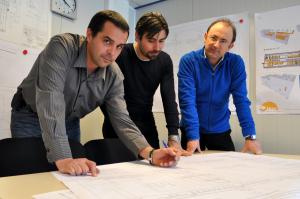Cablemen at work
More than 100,000 cables will be used in ITER for a total length of about 600 kilometres. Winding and wiggling into the innards of the Tokamak Complex they will connect components and transport power, signals and commands.
The environment in which cables will operate will be cramped and aggressive. Their organization, routing and integration require a lot of thinking and planning, especially since the installation will be in constant evolution.
Dealing with this complexity is the job of Joël Hourtoule's Steady State Electrical Network (SSEN) Section. He and his cablemen have experience in machines that resemble ITER: Joël was in charge of cable management at Tore Supra; David Beltran, ITER's newly appointed Cable Engineering Responsible Officer, comes fresh from the Spanish synchrotron CELLS and Cable Database Technical Engineer Jashwant Sonara was until recently with the Indian Steady State Superconducting Tokamak (SST-1).
ITER, however, is different, and not just because of its size and experimental nature. As components will be procured by the seven Domestic Agencies and as the installation is composed of various interacting "plant systems," the documentation issue is at the core of cable engineering's challenge.
"A nuclear operator must know his installation down to the smallest of its components," explains Joël. Descriptive documents, which safety authorities can request at any time, must be perfectly accurate and constantly updated. "This means that we must know precisely what goes into the components that are delivered through Procurement Arrangements, especially those that fall under the 'Functional Specification' category. It also means that we have to work in close collaboration with the different plant systems within ITER to centralize their data."
This will be accomplished by establishing procedures and "best practice" guidelines and by implementing tools to create and fill databases. "People in Plant Systems have experience from other installations. They know that when not properly managed a cable issue can turn into a nightmare ... and a costly one at that."
Last February, Joël and some of his colleagues, along with Central Integration & Engineering (CIE) specialists, participated in a meeting at Laser Megajoule (LMJ) near Bordeaux to discuss cable engineering strategies. The construction of the LMJ inertial fusion facility is presently at the stage where ITER will be six years from now, and there is a lot to learn from their experience.
Cable engineering in ITER is "an industrial and organizational issue, but not only," stresses Joël. "We need good will and a constant dialogue with our colleagues in the plant systems. What it comes down to in the end is that it's a human issue."


